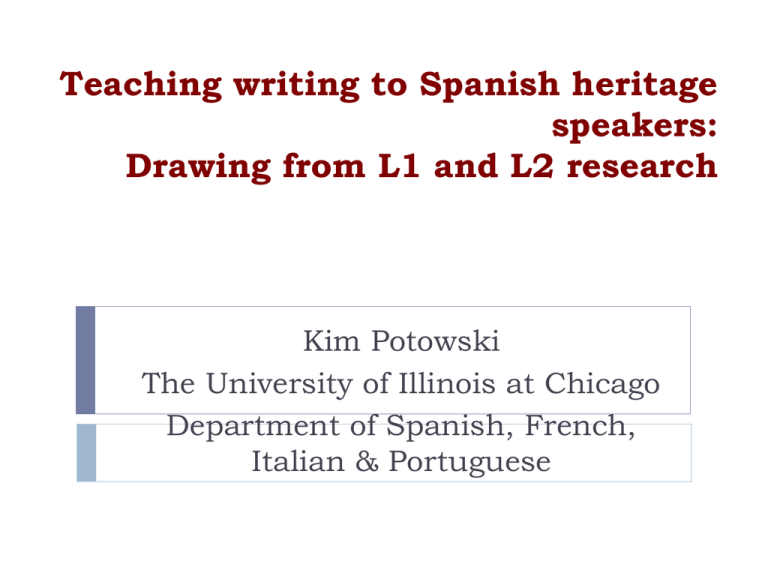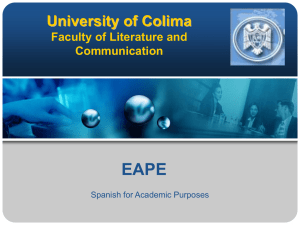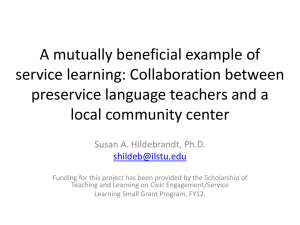Workshop: Teaching Spanish to Heritage Speakers
advertisement

Teaching writing to Spanish heritage speakers: Drawing from L1 and L2 research Kim Potowski The University of Illinois at Chicago Department of Spanish, French, Italian & Portuguese Teaching heritage speakers Need for theory of heritage language development (Valdés 2001) Classroom-based experimental studies: The development of Spanish heritage grammar: Potowski, Jegerski & Morgan-Short (2009): Processing instruction with the past subjunctive Montrul & Bowles (2010): Dative case marking The development of Spanish heritage speaking, reading, writing: ______________________________________ NHLRC survey results: How important is it for you to accomplish the following goals in your HL class? [1= unimportant, 5 = very important] What is writing? Continuum of activities that range from mechanical or formal aspects of "writing down" on the one end, to the more complex act of composing on the other end (Omaggio Hadley, 1993). Composing: the ability either to tell or retell pieces of information in a particular form (narratives, description) or to transform information into new texts (expository, argument). The ability to write well is not naturally acquired; usually learned in formal instructional settings. We know that SHS often have difficulties with writing in the HL Spicer-Escalante (2005): Heritage Spanish writers produced weaker thesis statements than either monolingual Spanish writers or Spanish L2 writers. Arguments tended to come from personal experiences more often than objective sources. Simple coordination: Tended to unite short sentences by a string of comas instead of using subordination. Difficulties with writing/composing: Lack of knowledge of the HL (general vocabulary, grammar, transition words, etc.) Lack of ability to write/compose in the L1 What we know generally about the academic preparation of many U.S. Latinos. Unclear tasks, lack of time & resources, etc. Selected characteristics of students who enroll in Spanish for Native Speakers language courses (from Valdés, 1997, p. 14). Types of students: Newly arrived (Types A & B) Bilingual (Types A-F) Types of students Characteristics Newly arrived-Type A Well-schooled in Spanish-speaking country Speakers of prestige variety of Spanish Newly arrived-Type B Poorly-schooled in Spanish-speaking country Speakers of stigmatized variety of Spanish Types of students Characteristics Bilingual-Type A Access to bilingual instruction in U.S. Basic academic skills in Spanish Good academic skills in English Fluent functional speakers of contact variety of rural Spanish Bilingual-Type B No academic skills in Spanish Good academic skills in English Fluent but limited speakers of contact variety of rural Spanish Bilingual-Type C No academic skills in Spanish Good academic skills in English Fluent but limited speakers of prestige variety of Spanish Some contact phenomena present Types of students Characteristics Bilingual-Type D No academic skills in Spanish Poor academic skills in English Fluent but limited speakers of contact variety of rural Spanish Bilingual-Type E No academic skills in Spanish Poor academic skills in English Very limited speaker of contact variety rural Spanish of Bilingual-Type F No academic skills in Spanish Poor academic skills in English Receptive bilingual in contact variety of rural Spanish At the university level we typically see: Newly arrived-Type A Well-schooled in Spanish-speaking country Speakers of prestige variety of Spanish Bilingual-Type A Access to bilingual instruction in U.S. Basic academic skills in Spanish Good academic skills in English Fluent functional speakers of contact variety Bilingual-Type B No academic skills in Spanish Good academic skills in English Fluent but limited speakers of contact variety Bilingual-Type C No academic skills in Spanish Good academic skills in English Fluent but limited speakers of prestige variety Some contact phenomena present We don’t know much about HS writing development Schwartz (2003): Think-aloud protocol to elicit students’ writing & revising strategies. Colombi (2003): Systemic functional linguistics. Builds abilities in identifying characteristics of academic register; lexicon; subordination; etc. Chevalier (2004): Proposed that students should initially draw on their knowledge of the spoken language; introduce norms of various written gradually, progress from less to more formal and more complex discourse type, with emphasis on text cohesion. Given the variety of sources of difficulties in HS writing, we should look to: Research on how to develop L1 composition skills language arts. Research on how L2 writing is developed What do we know about writing development from L1 and L2 research? Specifically: The genre of “Western argument.” Why argument? Description, narrative, poetry, and other forms of fiction/creative writing are certainly important in a repertoire of literacy skills. But most of the writing students do in college is argumentative in some fashion. Why “Western”? Fishman & Valdés (2000) found that most SHS work in the U.S. Characteristics of Western argumentative writing: Clear thesis statement, supporting points, exposition of competing opinions, conclusion. Work on developing L1 writing Most literature is K-12. College level: Graff, G. & Birkenstein, C. (2006). They say, I say: The moves that matter in academic writing. “Too often, academic writing is taught as a process of saying true or smart things in a vacuum, as if it were possible to argue effectively without being in a conversation with someone else. In the real world, we don’t make arguments without being provoked. We make arguments because someone has said or done something and we need to respond. You must find a way of entering a conversation with others’ views. If your own argument doesn’t identify the “they say” that you’re responding to, then it probably won’t make sense.” “They say” = The discussion. “I say” = The author’s thesis. They say, I say contains explicit instructions for students on: • • • • How to frame what others are saying How to summarize, quote, and distinguish their point from others’ points How to anticipate objections to their argument How to connect the parts of their argument. Provides students with templates such as this: “When it comes to the topic of __________, most of us will agree that __________. Where this agreement usually ends, however, is on the question of __________. Although ________, it is much more useful to _______________ .” Do templates stifle writers’ ideas or creativity? It has been argued that students who cannot write well cannot think well. This may be a chicken-or-egg question. But if thinking and writing are reciprocally supportive processes, guiding students in the use of these templates may help them sharpen their thinking. L2 writing: Myles (TESL, 2009) Academic writing requires conscious effort and practice in composing, developing, and analyzing ideas. However, language proficiency underlies the ability to write in the L2 in a fundamental way. Therefore, L2 writing instructors should take into account both strategy development and language skill development. A focus on the writing process as a pedagogical tool is only appropriate for second language learners if attention is given to linguistic development, and if learners are able to get sufficient and effective feedback with regard to their errors in writing. An L1 language arts approach When you studied your societal language in high school – e.g. Korean in Korea, English in suburban NY – what did you study? Literature Grammar (?) Spelling Writing Public speaking Other? Does this approach have value for heritage speakers? Particularly if supplemented with the kinds of linguistic support they need? Writing as a process Many times, writing assignments are given as a demand for a product. “Write a composition about your family.” Perhaps this directive will contain additional paramaters like: • “Three pages in length.” • “Use the vocabulary from page 19.” • “Use the present perfect.” Here’s what happens: Students turn in composition Instructor “grades” it & gives it back to students How much do students pay attention to instructor feedback? Metaphor: Cooking Tell an 18-year-old: “Prepare a pasta dish.” What will you likely get? • • • Use rigatoni. 6 servings. Use roasted red pepper. What could you tell the person to end up with a better product (dish)? What else is being served during the meal? Formal or informal setting? Any allergies, vegetarians, etc? What produce & other items are readily available? Cooking equipment? Step-by-step recipe For better products (compositions, dishes): Give necessary details about AUDIENCE and PURPOSE Provide a recipe Question: Does this restrain students too much? Restrict the development of personal style in writing? Recall Graff & Birkenstein (2006): Providing students with templates pushes them to develop sophisticated opinions. Three years to develop skills for strong writing (Hakuta, Butler & Witt 2000) Writing as a process 1) 2) 3) 4) Writing prompts (tasks) Audience & purpose Multiple drafts Feedback (1) Writing prompts Compare two writing assignments (see handout). What is different about Prompts A vs. B? Who is the audience? What is the purpose? What support is provided for the writing process? (2) Audience & purpose Even if it’s invented or feels a bit forced, students – particularly in lower level courses – should be provided with a concrete audience (beyond the instructor) and purpose. “Your purpose is to propose ways in which to reduce domestic violence. You will submit your proposal to the Mayor’s office in a competition to receive funding for your proposal.” “You will respond to letters about the changing of the name of the Sears Tower, and submit your letter to Hoy (local Spanish language newspaper).” (3) Multiple drafts At the University of Illinois at Chicago, we changed from: 3 compositions x 2 drafts each to 2 compositions x 3 drafts each Much higher quality. Grade: 40% = Draft 1 (primary focus = content) 50% = Draft 2 (increased focus on form) 10% = Quality of comments on peer review Peer review Very specific questions. Maybe one grammar point 10% of final grade (See example on handout) (4) Feedback Selective. Semke (1984) “The effects of the red pen”. Respectful. Clear rubric. Dependent on the version. NOTE: Nichols & Colon (2000): Use of mixed language during first drafts resulted in much stronger final texts. Normative spelling Very common in Spanish textbooks: word lists Words with C, S, Z Words with B, V Alternate approach: Spellchecker + focused practice on things the spellchecker can’t catch (some accents, homonyms) No: huviera, conosco, comio Yes: hablo vs. habló, esta vs. está, hacer vs. a ser Example of focused accent/spelling activities: Input followed by output The role of reading in writing development Have students dissect readings: What is the “they say,” “I say,” audience, purpose, etc.? Read like writers, write like readers. Towards building a research base What can classroom-based research on HS writing development look like? Pre-treatment, treatment, post-treatment What to measure? How to measure it? Lexical density Rubric-based grading: What categories? Templates vs. no templates Peer review vs. no peer review Can MLTs be useful? MLU = measure of linguistic oral productivity utilized to gauge the level of development of children’s speech. Calculated by collecting 100 utterances spoken by a child and dividing the number of morphemes by the number of utterances (Brown 1973; Klee 1999; Miller and Chapman 1981, 2000,; Parker 2005). MLU was applied to children’s writing and then to second language acquisition studies involving a number of languages (Cooper 1976 L2 German, Monroe 1975 L2 French, Vann 1978 L2 English) MLU MLT The adaptation of MLU to written language is called MLT or Mean Length of T-units (Hunt 1970). A tunit is the shortest unit that can stand alone as a sentence. For example: “He stopped and he sat down on the soft grass.” = 2 t-units (2 words and 7 words) “When he arrived home, Allen took a bath and quietly ate his dinner alone.” =1 t-unit, 14 words. The longer the t-unit, the more proficient the language sample is said to be. Informal examination of MLT Calculated MLT in 100 Spanish texts written by UIC heritage speakers as part of their Spanish placement exam. Experimental idea: Explicit instruction on how to combine sentences for longer MLTs? Thoughts/comments/questions Thank you!







